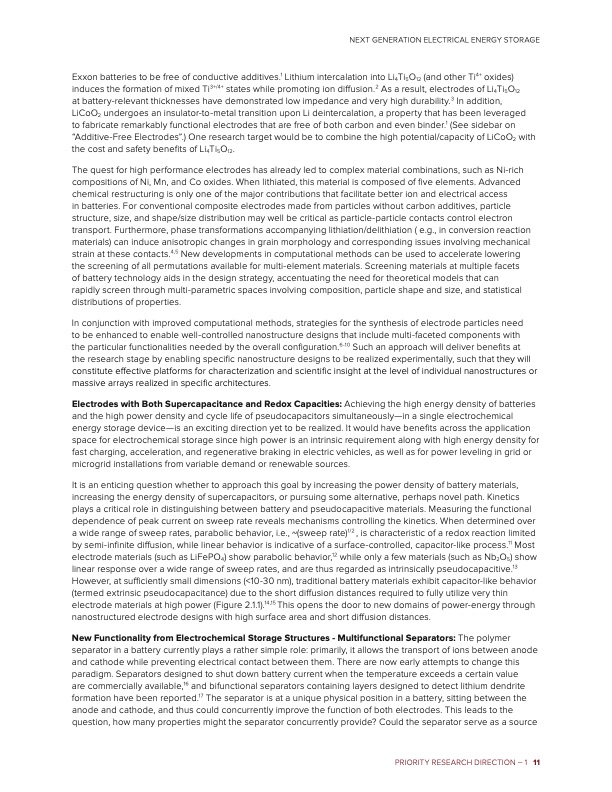
PDF Publication Title:
Text from PDF Page: 017
Exxon batteries to be free of conductive additives.1 Lithium intercalation into Li4Ti5O12 (and other Ti4+ oxides) induces the formation of mixed Ti3+/4+ states while promoting ion diffusion.2 As a result, electrodes of Li4Ti5O12 at battery-relevant thicknesses have demonstrated low impedance and very high durability.3 In addition, LiCoO2 undergoes an insulator-to-metal transition upon Li deintercalation, a property that has been leveraged to fabricate remarkably functional electrodes that are free of both carbon and even binder.1 (See sidebar on “Additive-Free Electrodes”.) One research target would be to combine the high potential/capacity of LiCoO2 with the cost and safety benefits of Li4Ti5O12. The quest for high performance electrodes has already led to complex material combinations, such as Ni-rich compositions of Ni, Mn, and Co oxides. When lithiated, this material is composed of five elements. Advanced chemical restructuring is only one of the major contributions that facilitate better ion and electrical access in batteries. For conventional composite electrodes made from particles without carbon additives, particle structure, size, and shape/size distribution may well be critical as particle-particle contacts control electron transport. Furthermore, phase transformations accompanying lithiation/delithiation ( e.g., in conversion reaction materials) can induce anisotropic changes in grain morphology and corresponding issues involving mechanical strain at these contacts.4,5 New developments in computational methods can be used to accelerate lowering the screening of all permutations available for multi-element materials. Screening materials at multiple facets of battery technology aids in the design strategy, accentuating the need for theoretical models that can rapidly screen through multi-parametric spaces involving composition, particle shape and size, and statistical distributions of properties. In conjunction with improved computational methods, strategies for the synthesis of electrode particles need to be enhanced to enable well-controlled nanostructure designs that include multi-faceted components with the particular functionalities needed by the overall configuration.6-10 Such an approach will deliver benefits at the research stage by enabling specific nanostructure designs to be realized experimentally, such that they will constitute effective platforms for characterization and scientific insight at the level of individual nanostructures or massive arrays realized in specific architectures. Electrodes with Both Supercapacitance and Redox Capacities: Achieving the high energy density of batteries and the high power density and cycle life of pseudocapacitors simultaneously—in a single electrochemical energy storage device—is an exciting direction yet to be realized. It would have benefits across the application space for electrochemical storage since high power is an intrinsic requirement along with high energy density for fast charging, acceleration, and regenerative braking in electric vehicles, as well as for power leveling in grid or microgrid installations from variable demand or renewable sources. It is an enticing question whether to approach this goal by increasing the power density of battery materials, increasing the energy density of supercapacitors, or pursuing some alternative, perhaps novel path. Kinetics plays a critical role in distinguishing between battery and pseudocapacitive materials. Measuring the functional dependence of peak current on sweep rate reveals mechanisms controlling the kinetics. When determined over a wide range of sweep rates, parabolic behavior, i.e., ~(sweep rate)1/2 , is characteristic of a redox reaction limited by semi-infinite diffusion, while linear behavior is indicative of a surface-controlled, capacitor-like process.11 Most electrode materials (such as LiFePO4) show parabolic behavior,12 while only a few materials (such as Nb2O5) show linear response over a wide range of sweep rates, and are thus regarded as intrinsically pseudocapacitive.13 However, at sufficiently small dimensions (<10-30 nm), traditional battery materials exhibit capacitor-like behavior (termed extrinsic pseudocapacitance) due to the short diffusion distances required to fully utilize very thin electrode materials at high power (Figure 2.1.1).14,15 This opens the door to new domains of power-energy through nanostructured electrode designs with high surface area and short diffusion distances. New Functionality from Electrochemical Storage Structures - Multifunctional Separators: The polymer separator in a battery currently plays a rather simple role: primarily, it allows the transport of ions between anode and cathode while preventing electrical contact between them. There are now early attempts to change this paradigm. Separators designed to shut down battery current when the temperature exceeds a certain value are commercially available,16 and bifunctional separators containing layers designed to detect lithium dendrite formation have been reported.17 The separator is at a unique physical position in a battery, sitting between the anode and cathode, and thus could concurrently improve the function of both electrodes. This leads to the question, how many properties might the separator concurrently provide? Could the separator serve as a source NEXT GENERATION ELECTRICAL ENERGY STORAGE PRIORITY RESEARCH DIRECTION – 1 11PDF Image | Next Generation Electrical Energy Storage

PDF Search Title:
Next Generation Electrical Energy StorageOriginal File Name Searched:
BRN-NGEES_rpt-low-res.pdfDIY PDF Search: Google It | Yahoo | Bing
Sulfur Deposition on Carbon Nanofibers using Supercritical CO2 Sulfur Deposition on Carbon Nanofibers using Supercritical CO2. Gamma sulfur also known as mother of pearl sulfur and nacreous sulfur... More Info
CO2 Organic Rankine Cycle Experimenter Platform The supercritical CO2 phase change system is both a heat pump and organic rankine cycle which can be used for those purposes and as a supercritical extractor for advanced subcritical and supercritical extraction technology. Uses include producing nanoparticles, precious metal CO2 extraction, lithium battery recycling, and other applications... More Info
| CONTACT TEL: 608-238-6001 Email: greg@infinityturbine.com | RSS | AMP |